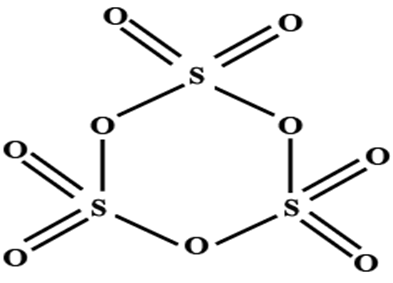
Identify the Number of pi bonds in the cyclic structure of
Answer
514.8k+ views
Hint: To calculate the number of π bonds, we need to know how many single, double and triple bonds are present in the compound. We have already learned in previous classes that every double bond contains one pi bond and one sigma bond.
Complete step by step solution:
Cyclic structure of

From the structure we can see,
We know for cyclic compounds:
Each single bond contains one sigma bond.
Every double bond contains one sigma and one pi bond.
Every triple bond contains one sigma and two pi bonds.
In the above structure we can see there are 6 double bonds and no triple bond. Each double bond contributes one pi bond.
Hence, there are 6 π bonds in the cyclic structure of
Additional Information:
A double bond is formed by lateral overlap of atomic orbital’s thus always a sigma bond forms first followed by pi bond. When we see an organic compound try to calculate no. of sigma bonds in the compound for double bond a sigma and a pi bond are formed and for triple bond a sigma and two pi bonds are formed irrespective of type of atom. In general, the overlap of n atomic orbital’s will create n molecular orbital’s.
Note: Some of us have this wrong notion that a sigma bond is the result of the overlapping of s orbital and a pi bond is the result of the overlapping of p orbitals because they may relate this “s” to 'sigma' and the 'p' to 'pi'. However, it is seen that sigma bonds can be formed by the overlapping of both the s and p-orbitals and not just s-orbital.
Complete step by step solution:
Cyclic structure of

From the structure we can see,
We know for cyclic compounds:
Each single bond contains one sigma bond.
Every double bond contains one sigma and one pi bond.
Every triple bond contains one sigma and two pi bonds.
In the above structure we can see there are 6 double bonds and no triple bond. Each double bond contributes one pi bond.
Hence, there are 6 π bonds in the cyclic structure of
Additional Information:
A double bond is formed by lateral overlap of atomic orbital’s thus always a sigma bond forms first followed by pi bond. When we see an organic compound try to calculate no. of sigma bonds in the compound for double bond a sigma and a pi bond are formed and for triple bond a sigma and two pi bonds are formed irrespective of type of atom. In general, the overlap of n atomic orbital’s will create n molecular orbital’s.
Note: Some of us have this wrong notion that a sigma bond is the result of the overlapping of s orbital and a pi bond is the result of the overlapping of p orbitals because they may relate this “s” to 'sigma' and the 'p' to 'pi'. However, it is seen that sigma bonds can be formed by the overlapping of both the s and p-orbitals and not just s-orbital.
Recently Updated Pages
Master Class 9 General Knowledge: Engaging Questions & Answers for Success

Master Class 9 English: Engaging Questions & Answers for Success

Master Class 9 Science: Engaging Questions & Answers for Success

Master Class 9 Social Science: Engaging Questions & Answers for Success

Master Class 9 Maths: Engaging Questions & Answers for Success

Class 9 Question and Answer - Your Ultimate Solutions Guide

Trending doubts
Give 10 examples of unisexual and bisexual flowers

Draw a labelled sketch of the human eye class 12 physics CBSE

Differentiate between homogeneous and heterogeneous class 12 chemistry CBSE

Differentiate between insitu conservation and exsitu class 12 biology CBSE

What are the major means of transport Explain each class 12 social science CBSE

a Tabulate the differences in the characteristics of class 12 chemistry CBSE




